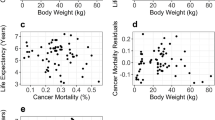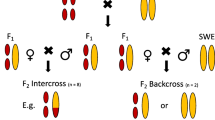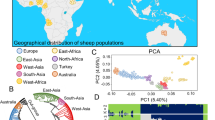Abstract
A total of 88 wild mice from the Dalmatian coast of Yugoslavia (35 animals), and Peloponnesus (30 animals) and Thebes (23 animals) on mainland Greece were karyotyped. In all but five animals Robertsonian translocations were found. Mice from the Dalmatian region were homozygous for translocations Rb(5.15), Rb(6.12), Rb(8.17), Rb(9.13), and Rb(10.14); they were homo-or heterozygous for the translocation Rb(1.11). Some of them lacked the Rb(1.11) translocation altogether so that the diploid numbers in the Yugoslavian mice were 2n=28, 29, 30, or 40. The mice from the vicinity of Olympia in northwestern Peloponnesus were homozygous for eight Robertsonian translocations: Rb(1.3), Rb(2.5), Rb(4.6), Rb(8.12), Rb(9.16), Rb(10.14), Rb(11.17), and Rb(13.15). Their diploid chromosome number was therefore 2n=24. Mice from the vicinity of Patras in northwest Peloponnesus carried all except the first three of these eight translocations; their chromosome number was 2n=30. Finally, the mice from Thebes were homozygous for translocations Rb(2.15), Rb(4.14), Rb(5.12), and Rb(10.13). They were homo- or heterozygous for Rb(6.9), Rb(8.17), and Rb(1.11); some mice lacked the Tb(1.11) translocation altogether. The translocations Rb(6.9)40Tu and Rb(10.13)42Tu represent new arm combinations not found previously in any wild mouse population. the remaining translocations have previously been found in different Mediterranean countries, in Scotland and in southern Germany. The findings suggest that each translocation arose only once and that different translocations have come together in different populations to generate a unique karyotype characterizing this population.
Similar content being viewed by others
References
Adolph S (1984) tRobertsonsche Translokationen bei württembergischen Hausmäusen (Mus musculus domesticus) — Ein Beispiel zur Chromosomenevolution. Jh Ges Naturkde Württ 139:67–92
Adolph S, Klein J (1981) Robertsonian variation in Mus musculus from Central Europe, Spain, and Scotland. J Hered 72:219–221
Adolph S, Klein J (1983) Genetic variation of wild mouse populations in Southern Germany. Genet Res 41:117–134
Barren PR, Morris SM, Schol H, Bishop JB (1982) A method for preparing chromosomes from peripheral blood of the mouse. Mutat Res 104:159–163
Brooker P (1982) Robertsonian translocations in Mus musculus from NE Scotland and Orkney. Heredity 48:305–309
Capanna E, Cristaldi M, Perticone P, Rizzoni M (1975) Identification of chromosomes involved in the nine Robertsonian fusions of the Apennine mouse with a 22-chromosome karyotype. Experientia 31:294–296
Capanna E, Gropp A, Winking H, Noack G, Civitelli M-V (1976) Robertsonian metacentrics in the mouse. Chromosoma 58:341–353
Capanna E, Civitelli M-V, Cristaldi M (1977) Chromosomal rearrangement, reproductive isolation and speciation in mammals. The case of Mus musculus. Boll Zool 44:213–246
Capanna E, Riscassi E (1978) Robertsonian karyotype variability in natural Mus musculus populations in the Lombardy area of Po valley. Boll Zool 45:63–71
Capanna E (1980) Chromosomal rearrangement and speciation in progress in Mus musculus. Folia Zool 29:43–57
Capanna E (1982) Robertsonian numerical variation in animal speciation. Mus musculus, an emblematic case. In: Barigozzi C (ed) Mechanisms of speciation. Alan R. Liss, New York, pp 155–174
Capanna E (1985) Caryotype variability and chromosome transilience in rodents: The case of the genus Mus. In: Luckett P, Hortenberger J-H (eds) Evolutionary relationships among rodents. Nato ASI Series A, vol. 92, pp 643–669
Cowell JK (1984) A photographic representation of the variability of the G-banded structure of the chromosomes of the mouse karyotype. Chromosoma 89:294–320
Dulić B, Soldatović B, Dunderski Z (1980) Distribution of karyotypes in Mus musculus Linnaeus, 1758 (Rodentia, Muridae) in some regions of Yugoslavia. Biosistematika 6:203–210
Gropp A, Tettenborn U, Lehmann E v (1970) Chromosomenvariation vom Robertson'schen Typus bei der Tabakmaus, M. poschiavinus und ihren Hybriden mit der Laboratoriumsmaus. Cytogenetics 9:9–23
Gropp A, Olert J, Maurizio R (1971) Robertsonian chromosomal polymorphism in the mouse. Experientia 27:1226–1227
Gropp A, Winking H, Zech L, Müller HJ (1972) Robertsonian chromosomanl variation and identification of metacentric chromsomes in feral mice. Chromosoma 39:265–288
Gropp A, Winking H (1981) Robertsonian translocations: cytology meiosis, segregation patterns and biological consequences of heterozygosity. In: Berry RJ (ed) Biology of the house mouse. Academic Press, London, pp 141–181
Gropp A, Winking H, Redi CA, Capanna E, Britton-Davidian J, Noack G (1982) Robertsonian karyotype variation in wild house mice from Rhaeto-Lombardia. Cytogenet Cell Genet 34:67–77
Hübner R, Koulischer L, Lichtenberger M (1985) A robertsonian translocation in wild mice from Belgium. Mouse News Lett 72:116–117
Lehman E v, Radbruch A (1977) Robertsonian translocations in Mus musculus from Sicily. Experientia 33:1025–1026
Leonard A, DeKnudt GH (1967) A new marker for chromosome studies in the mouse. Nature 214:504–505
Lyon MF (1981) Rules for nomenclature of chromosome anomalies. In: MC Green (ed) Genetic variants and strains of the laboratory mouse. Gustav Fischer Verlag, Stuttgart, pp 314–323
Nesbitt MN, Francke U (1973) A system of nomenclature for band patterns of mouse chromosomes. Chromosoma 41:145–158
Robertson WM, Rees B (1916) Chromosome studies. I. Taxonomy relationships shown in the chromosomes of Lettigidae and Acrididae. Chromosomes and variations. J Morphol 27:179–331
Robinson TJ (1978) Preliminary report of a Robertsonian translocation in an isolated feral Mus musculus population. Mamm Chrom Newslett 19:84–85
Said K, Jacquart T, Montgelard C, Sonjaya H, Helal AN, Britton-Davidian (1986) Robertsonian house mouse populations in Tunesia. A karyological and biochemical study. Genetica 68:191–196
Seabright J (1971) A rapid banding technique for human chromosomes. Lancet ii: 971–972
Winking H, Gropp A, Bulfield G (1981) Robertsonian chromosomes in mice from North-eastern Greece. Mouse News Lett 64:69–70
Author information
Authors and Affiliations
Rights and permissions
About this article
Cite this article
Tichy, H., Vucak, I. Chromosomal polymorphism in the house mouse (Mus domesticus) of Greece and Yugoslavia. Chromosoma 95, 31–36 (1987). https://doi.org/10.1007/BF00293838
Received:
Issue Date:
DOI: https://doi.org/10.1007/BF00293838




